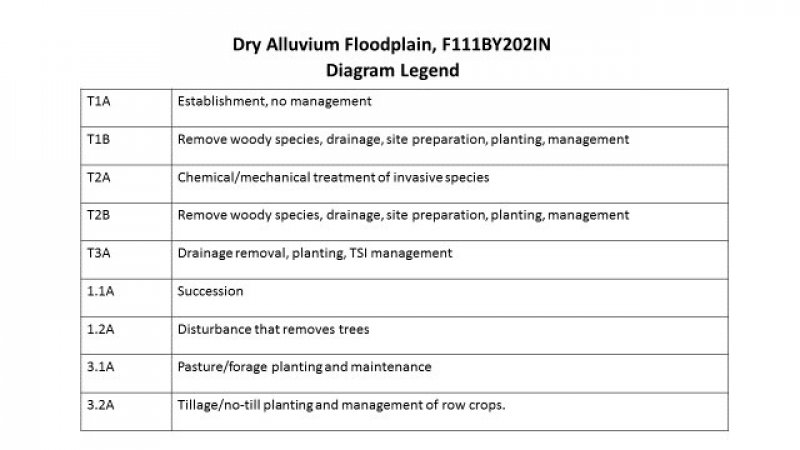
Natural Resources
Conservation Service
Ecological site F111XB202IN
Dry Alluvium Floodplain
Last updated: 9/11/2024
Accessed: 12/22/2024
General information
Provisional. A provisional ecological site description has undergone quality control and quality assurance review. It contains a working state and transition model and enough information to identify the ecological site.
MLRA notes
Major Land Resource Area (MLRA): 111X–Indiana and Ohio Till Plain
111B – Indiana and Ohio Till Plain, Northeastern Part. This area is in the Eastern Lake and Till Plains Sections of the Central Lowland Province of the Interior Plains. The entire MLRA is glaciated, and most areas are dominated by ground moraines that are broken in places by lake plains, outwash plains, flood plains, and many recessional moraines. The ground moraines and lake plains in front of the recessional moraines are flat to undulating. In many places stream valleys occur at the leading edge of the recessional moraines. Narrow, shallow valleys commonly are along the major rivers and streams in this MLRA, and some areas along the major rivers and streams have deposits of sand. Elevation ranges from 630 to 1,550 feet (190 to 470 meters), increasing gradually from west to east. Relief is mainly a few meters, but in some areas hills rise as much as 100 feet (30 meters) above the adjoining plains.
The extent of the major Hydrologic Unit Areas (identified by four-digit numbers) that make up this MLRA is as follows: Western Lake Erie (0410), 41 percent; Wabash (0512), 28 percent; Scioto (0, 28 percent; Scioto (0506), 10 percent; St. Clair-Detroit (0409), 9 percent; Great Miami (0508), 6 percent; Southeastern Lake Michigan (0405), 5 percent; and Southwestern Lake Huron (0408), 1 percent. The Huron River in Michigan, Cedar Creek in Indiana, and the Sandusky River in Ohio have been designated as National Wild and Scenic Rivers in this MLRA.
The surficial materials in this area include glacial deposits of till, outwash, and lacustrine sediments from Wisconsin and older glacial periods. A thin mantle of loess occurs in some areas. Most of the MLRA is underlain by Silurian and Devonian limestone and dolostone. Middle Devonian to Early Mississippian black shale and Early to Middle Mississippian siltstone and shale are in some areas of the northern part of the MLRA.
Classification relationships
Major Land Resource Area (USDA-Natural Resources Conservation Service, 2006)
USFS Ecological Regions (USDA, 2007):
Sections –Central Till Plains, Beech Maple (222H), South Central Great Lakes (222J)
Subsections – Bluffton Till Plains (222Ha), Bluffton-Ann Arbor Till Plains (222Je), Jackson Interlobate Moraine (222Jg), Steuben Interlobate Moraines (222Ji)
NatureServe Systems anticipated (NatureServe, 2011): Agriculture - Cultivated Crops and Irrigated Agriculture, Agriculture – Pasture/Hay, North-Central Interior Beech-Maple Forest, North-Central Interior Floodplain
LANDFIRE Biophysical Settings anticipated (USGS, 2010): Central Interior and Appalachian Floodplain Systems
Ecological site concept
This site is a wetland/riparian site formed on alluvium parent materials in soils that are moderately well to well drained. These soils generally occur on floodplains, on flat topography, with slopes from 0 to 2 percent. The soil surface color is dark in color (3/2 Munsell or darker) with a silt loam texture.
The characteristic vegetation of the site is a floodplain forest with the understory and canopy dominated by fire sensitive, shade tolerant species most notably Ohio buckeye and red maple, with box elder and tulip tree also being common. Canopy level associates include white oak, basswood, and black walnut. Active hydrologic and geomorphic process, along with windthrow of established trees, drive the long interval disturbance regime of this tree dominated site. These macro and micro scale disturbance events creates mixed-aged forests that contains both late and early seral species. These dynamics have been drastically changed due to the installation of levees, dams, and channelization of the system. Establishment of woody non-native, invasive species, followed by no management to control them, can alter the state of the site. The invasive species can persist in the understory as a component and then spread rapidly with an opening in the canopy. They can come to dominate the understory of the site, while the canopy level species remain, relatively, unchanged. Removal of the woody species, installation of tile, and agricultural practices move this site to a new state. Much of the historic acres of this site have been transitioned to agriculture with the bulk of those acres being in corn and soybean rotations.
Associated sites
| F111XB201IN |
Wet Alluvium Floodplain Wet Alluvium Floodplain. Soils are in the aquic taxonomic suborder. |
|---|---|
| F111XB204IN |
Dry Alluvium Forest Dry Alluvium Forest. Soil surface is light in color and moderately well drained or drier. |
| F111XB203IN |
Wet Alluvium Forest Wet Alluvium Forest. Soil surface is light in color and very poorly to SWPD. |
Similar sites
| F111XB204IN |
Dry Alluvium Forest Dry Alluvium Forest. Soil surface is light in color and moderately well drained or drier. |
|---|
Table 1. Dominant plant species
| Tree |
(1) Aesculus glabra |
|---|---|
| Shrub |
Not specified |
| Herbaceous |
Not specified |
Click on box and path labels to scroll to the respective text.



